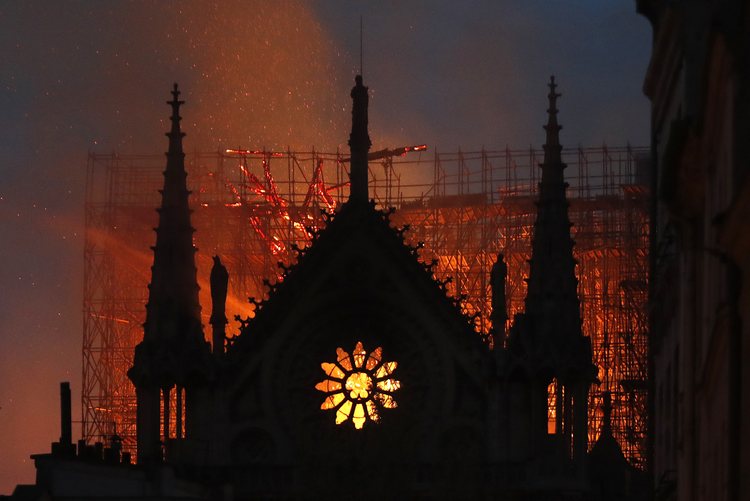From The Ashes – Fifth Sunday of Easter 2019

One could select scriptural passages from the Acts of the Apostles that give the impression of a unified Church in its earliest days. However, we know that there are as many passages in the New Testament that betray the reality – skirmishes and arguments and fights on different sides of an issue. Take a look at Paul’s letters.
Today’s Gospel includes Jesus’ plea that we love one another. I don’t think that it is far-fetched to suggest that he would offer that reminder at any point in Church history. That is no less true today than it was in the early Christian community.
I’m writing this in Holy Week, in mid-April, just a day after the devastating fire at Notre Dame Cathedral in Paris.
And, just a week before that, the 92-year old Benedict XVI added fuel to the fires of controversy in the Church’s conflicts over theology and sex abuse. Recall his infamous links between the sex abuse crisis and the cultural revolution of the 1960s and 1970s.
A few commentators linked those seemingly divergent events in Paris and Rome, notably Ross Douthat writing in The New York Times on April 15, 2019 (From the Ashes of Notre-Dame – How a burning cathedral rebukes a divided Catholic Church).
Douthat stated that Benedict’s intervention “contributes to the sense of a church in pieces, a church almost with two popes, each offering partial diagnoses to their respective factions.” He says that this adds to the situation of the pope and the former pope as being “symbols gripped by partisans.” This is not just about the sex abuse crisis.
It is the problem of Roman Catholicism in this age – “an age in which the church mirrors the polarization of Western culture,” rather than seeking a synthesis. That’s where Douthat brings in Notre-Dame. He describes the cathedral as “a particularly triumphant moment of Catholic synthesis … a new hybrid civilization embodied in the cathedral’s brooding, complicated, gorgeous sprawl.”
Douthat’s critique of contemporary Catholicism is that we have no grand synthesis to offer; we are torn between competing visions of how to be Catholic in the 21st-century. He suggests that both sides see themselves as the fire fighters inside the cathedral, trying to extinguish the flames and restore order. He offers further comments, connecting what he terms the civil wars in the Church with the image of a burning cathedral
The cathedral will be rebuilt. But Douthat suggests that the real challenge for us in a post-Christian world is “to look at what our ancestors did and imagine what it would mean to do that again, to build anew, to leave something behind that could stand a thousand years.” Is a synthesis possible? Can we surmount the scandals and anger of our present reality?
The destruction of Notre-Dame offers many images as we contemplate the life of the Church at this time in history. As I watched the cathedral burn, I couldn’t but help view it as a physical image of the sad levels of destruction that are occurring through the sins of so many in the Church.




Eileen Curran
Posted at 07:52h, 19 MayThank you for this. It clarifies the difficulties, and roots of the problems in the church for me. Very sad, but must struggle on, and your writings always help me.
Jeanette Woodley
Posted at 07:55h, 19 MayFather Philip, your comments here are very intuitive. Thank you.
Esther Buckley
Posted at 09:22h, 19 MayThank you for your writings . You have shown so much insight in your blog this week . I especially share your thoughts in the last paragraph of your blog. and had the same views as I watched the burning of the Notre Dame cathedral in Paris .
I look forward every week to your writings as well as the writings of others .
Charles Pottie-Pâté, sj
Posted at 13:58h, 19 MayThank you Phil for your reflection on today’s readings. The great synthesis, according to Douthat, exemplified in the Cathedral of Notre Dame in Paris, needs to be put in the context of the 13th century and before and after, with all its accompanying struggles for humanity and the church at that time. It is always dangerous to put any one period of our history as a pinnacle of unity and integration. Even the early history of the Christian community, as you noted in your comments, had its strifes, divisions, etc.
I would suggest that we look at a different kind of “synthesis” for our age. For example, the life, mission and legacy of Jean Vanier and the L”Arche communities and the Faith and Light communities, illustrate so well the Gospel message today – men and women with and without disabilities (the marginalised, the vulnerable of whatever kind) living together to form communities of love and service as signs of what God’s reign of peace, justice, love and joy looks like. These communities are the signs of hope in our world today, even as the great cathedrals of the past were in the past.